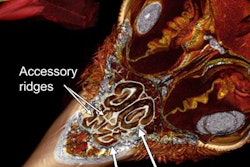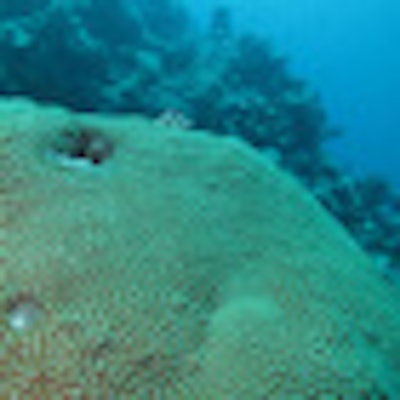
Though global warming may remain a popular topic of debate, its damage to a major coral species in the Red Sea is clear to a group of U.S. researchers, thanks to CT. By adapting 3D CT techniques to examine Diploastrea heliopora, they found that growth of the coral has declined by 30% since 1998.
Growth of the coral could cease altogether by 2070 if sea surface warming trends continue, according to the research from Woods Hole Oceanographic Institution (WHOI) of Woods Hole, MA, published in Science (July 16, 2010, Vol. 329:5989, pp. 322-325).
The group found that CT's ability to scan coral samples noninvasively offered a major improvement over previous techniques based on x-ray, which required coral samples to be cut into slices before they could be imaged.
Global warming's impact
Rising sea surface temperatures are problematic because they affect the symbiotic relationship between coral and zooxanthellae algae -- photosynthesis by the algae supports skeletal growth, or calcification, of the coral. Such increases in temperature, according to the group, are being witnessed in the Red Sea.
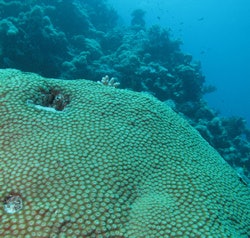 |
| D. heliopora in the Red Sea. Image courtesy of Woods Hole Oceanographic Institution. |
In the 1980s, "the average summer [water] temperatures were below 30° C," he said. "In 2008 they were approaching 31°."
Although that doesn't seem like much, it can have a major impact on sensitive ecosystems like the Red Sea.
"A prolonged increase of ~1° C or more above historical maximum sea surface temperatures can result in substantial loss of zooxanthellae or 'bleaching,' cessation of calcification, and in some cases coral mortality," Cantin, co-lead investigator Anne Cohen, and colleagues wrote.
Trouble brews below
Despite summer temperatures remaining about 1.5° C higher than the historic mean since 1998, the researchers were surprised by the findings, according to the WHOI statement. The colonies showed no signs of thermal stress or bleaching, in which the coral turns white from algae loss. However, "the CT scans reveal that these corals have actually been under chronic stress for the last 10 years," said Cohen, a research specialist at Woods Hole.
"The corals look healthy, but looking inside at the skeleton gives you an idea of things to come," she said. "It's like osteoporosis. You look at a person and, on the outside, everything seems fine, but inside there are signs of trouble."
The coral skeletons display annual growth bands, which the researchers visualized with CT. From these bands, they then established the age and linear extension of the coral, and investigated the relationship between growth and temperature encompassing the years 1930 to 2008.
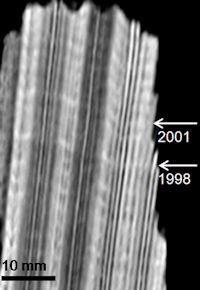 |
| A 2.5-mm thick virtual 2D slice cut parallel to the growth axis highlights two unusually high-density bands corresponding with high-temperature events in 1998 and 2001. Woods Hole Oceanographic Institution/Science Magazine. |
The samples were scanned along a transaxial plane, and an ultrahigh bone algorithm and 0.1-mm increments were used for reconstruction. Software from Visage Imaging of San Diego was utilized for 3D reconstructions from DICOM files and virtual image manipulation, including rotation and slicing, they noted.
Though x-ray has been used in the past for examining coral skeletons, CT offers the advantage of noninvasive examination, according to Cantin. "The biggest advantage we have over x-ray is that we can scan intact cores without cutting the core into thin slices," he said. "Since corals do not grow in a straight line, when the core is cut, inevitably the growth axis will be lost from a thin cut. Maintaining the vertical growth axis is crucial for us to visualize the annual density banding patterns."
With CT and 3D reconstruction, the reconstructed core images could be rotated according to the growth axis, and virtual 2D slices could be cut from the 3D images, repeatedly and at whatever angle or thickness proved most useful in visualizing the bands.
"X-ray requires that we cut the core 'blind' beforehand, before we know what the orientation of growth is. Whole cores can be sacrificed this way," he said. "With CT scanning, our cores are imaged intact, nothing else is required. This is a huge leap forward over x-ray."
Numbered days for D. heliopora?
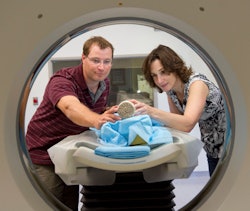 |
| Cantin and Cohen examine a Red Sea specimen. Photo by Tom Kleindinst, Woods Hole Oceanographic Institution. |
"Conversely, the most recent warm sea surface temperature anomaly is persistent," they wrote. "Since 1998, [sea surface temperatures] at our study site have remained at 0.9° to 2.2° C above historical mean values," corresponding with a 30% decline in growth compared to pre-1997 rates.
Using climate models from the Intergovernmental Panel on Climate Change, the researchers estimate that summer sea surface temperatures will continue to rise along with increases in atmospheric CO2 levels -- by 2099, reaching 2.5° C to 3° C over the 2000-2008 mean temperature.
However, according to their calculations, coral growth will have stopped completely before then.
"Extrapolating our empirically derived coral growth-sea surface temperature relationship, we expect that D. heliopora will cease calcifying altogether by 2070, when summer sea surface temperatures will exceed current summer values by 1.85° C," they wrote.
"The data in hand suggest that without immediate, aggressive global intervention to reduce carbon emissions ... the pressures of predicted annual heat stress will most certainly result in further deterioration of coral health in the central Red Sea over this century," the group concluded.
By Nicole Pettit
AuntMinnie.com staff editor
August 3, 2010
Copyright © 2010 AuntMinnie.com






